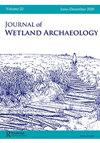Early Middle Ages Fishweirs, Dendrochronology and Wood Supply in Western France: The Case of the Léguer Estuary, Servel-Lannion, Northern Brittany, France
Q1 Arts and Humanities
引用次数: 3
Abstract
Abstract Between the fifth and the seventh century AD, Brittany was colonized and evangelized by Celtic populations from Wales and Ireland. Saint Efflam, who was the son of an Irish king, was according to oral tradition one of them. The value of this character is to deliver, through his Vita which was probably transcribed during the eighth century, incredibly accurate descriptions of a set of stone fishweirs at the foot of the ancient city of Yaudet (Coz Yoded) owned by a local lord. This area has already revealed a rich Iron Age, Roman and medieval heritage (). As a consequence, an archaeological survey started in 2011 in the mouth of the small river of Lannion (northern coast of Brittany), where 11 stone fishweirs are still visible. Four classical ‘V-shape’ superimposed structures were selected to determine the first chronological frame of these settlements. Among them, one of the oldest was particularly well preserved: a stone phase is supported by a level of wattle panels and ferns, dated by radiocarbon to 1430±30 BP: 580–660 cal AD. This structure has some similarities both in its shape and in its period of use with that described in the Life of Saint Efflam. But, it is undoubtedly the discovery of an earlier phase under the wall, made entirely of wood and dated from AD 615, which holds more in store for us.中世纪早期法国西部的鱼塘、树木年代学和木材供应:以法国布列塔尼北部servell - lannion的l河口为例
在公元5世纪到7世纪之间,布列塔尼被来自威尔士和爱尔兰的凯尔特人殖民并传播福音。圣埃夫拉姆是一位爱尔兰国王的儿子,根据口头传说,他就是其中之一。这个角色的价值在于,通过他可能在8世纪抄写的Vita,他对当地领主拥有的Yaudet (Coz Yoded)古城脚下的一组石头鱼塘进行了令人难以置信的准确描述。这个地区已经发现了丰富的铁器时代、罗马和中世纪的遗产。因此,2011年,一项考古调查开始在兰尼翁河(布列塔尼北部海岸)的河口进行,在那里仍然可以看到11个石鱼堰。选择了四个经典的“v形”叠加结构来确定这些定居点的第一个时间框架。其中,最古老的一个保存得特别完好:一个石头阶段由一层柳树板和蕨类植物支撑,通过放射性碳测定可以追溯到1430±30 BP,即公元580-660 cal。这个结构在形状和使用时期上与《圣埃夫拉姆传》中描述的结构有一些相似之处。但是,毫无疑问,在墙下发现的早期阶段,完全由木头制成,可追溯到公元615年,这为我们提供了更多的信息。
本文章由计算机程序翻译,如有差异,请以英文原文为准。
求助全文
约1分钟内获得全文
求助全文
来源期刊

Journal of Wetland Archaeology
Arts and Humanities-Archeology (arts and humanities)
CiteScore
1.40
自引率
0.00%
发文量
6
期刊介绍:
The Journal of Wetland Archaeology publishes a wide range of contributions in all fields of wetland archaeology. It includes scientific and methodological features, geoprospection, environmental reconstruction, wetland hydrology, cultural aspects of wetland archaeology, as well as conservation, site management, legislation, and site protection. All periods and all geographic regions are covered.
 求助内容:
求助内容: 应助结果提醒方式:
应助结果提醒方式:


